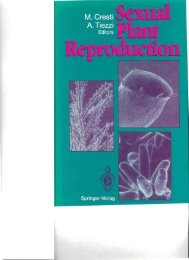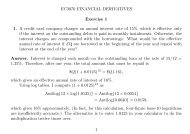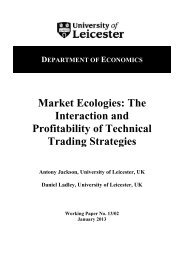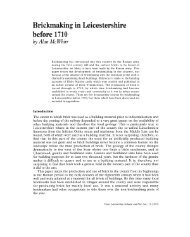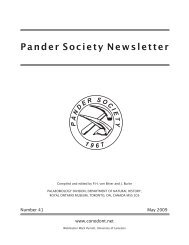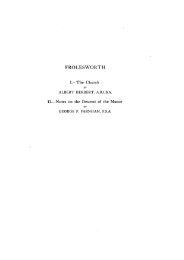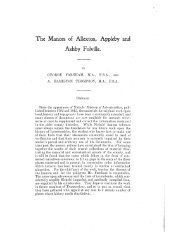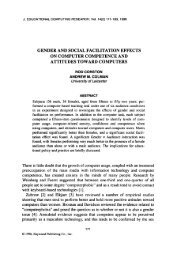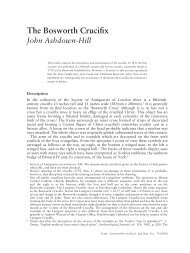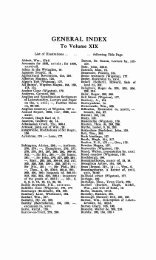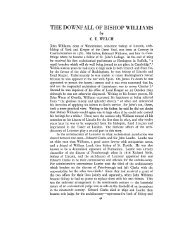Pander Society Newsletter - University of Leicester
Pander Society Newsletter - University of Leicester
Pander Society Newsletter - University of Leicester
You also want an ePaper? Increase the reach of your titles
YUMPU automatically turns print PDFs into web optimized ePapers that Google loves.
Symposia<br />
<strong>Pander</strong>'s legacy, 150 years on. 2006 marks the Sesquicentennial <strong>of</strong> <strong>Pander</strong>'s monograph in which<br />
conodonts were described for the first time. This symposium will consider <strong>Pander</strong> and his scientific<br />
contribution, including his work on conodonts, other fossil vertebrates, and developmental biology.<br />
Keynote speakers in this symposium will include Dick Aldridge who will be speaking on <strong>Pander</strong> and the<br />
phylogenetic position <strong>of</strong> the conodonts - then and now; Simon Knell (Museum Studies, <strong>Leicester</strong>), on<br />
<strong>Pander</strong>'s contributions in their historical context and subsequent work; Anthony Graham (Developmental<br />
Biology, King's College, London) on <strong>Pander</strong>'s seminal work in developmental biology; Peter Forey<br />
(Palaeontology, Natural History Museum) on <strong>Pander</strong> 1856 and ostracoderm vertebrates - from bits <strong>of</strong> scale<br />
to living fishes<br />
Conodont phylogenies - alternative approaches, implications, and applications. Hypotheses <strong>of</strong> conodont<br />
phylogeny underpin many areas <strong>of</strong> conodont research, including taxonomy, biostratigraphic zonation,<br />
evolutionary palaeobiology, and analysis <strong>of</strong> the quality <strong>of</strong> the fossil record. This session will explore<br />
alternative approaches to reconstructing conodont phylogeny, their assumptions, implications and<br />
applications. Keynote: Philip Donoghue.<br />
Conodonts, Palaeobiogeography and Palaeoceanography. Convened by Dick Aldridge, this session will<br />
cover all aspects <strong>of</strong> global influences on conodont distribution and the uses <strong>of</strong> conodonts in the<br />
investigation <strong>of</strong> palaeocontinental configurations, eustatic sea-level changes, climate models and the<br />
ocean/atmosphere system. Topics will include conodont biogeography, conodont geochemistry and the<br />
relationship between conodont distribution and sequence stratigraphy. Investigations <strong>of</strong> major patterns <strong>of</strong><br />
extinction, radiation and faunal turnover will also be relevant. Keynote: Chris Barnes.<br />
Triassic Conodonts: Taxonomy and Time Scales. Convened by Mike Orchard. Conodonts play a primary<br />
role in Triassic biochronology and yet the taxonomic framework in which they are applied remains largely<br />
based on form taxonomic concepts. This symposium will explore both the variability <strong>of</strong> taxonomic<br />
approaches currently in use in the study <strong>of</strong> Triassic conodonts, including their Permian forebears, and their<br />
application in biostratigraphy and time scales. Keynote: Mike Orchard<br />
'Coniform' Conodont Apparatuses and Architecture - Whence and Whither? Convened by Paul Smith<br />
and John Repetski. The last two decades have seen a major leap forward in the interpretation <strong>of</strong> more<br />
derived conodonts, with the elucidation <strong>of</strong> apparatus architectures using natural assemblages and the use <strong>of</strong><br />
these architectural models as templates for apparatus reconstruction in taxa unrepresented by natural<br />
assemblages. In contrast, primitive conodonts with apparatuses composed <strong>of</strong> coniform elements are poorly<br />
represented by natural assemblages and it is clear that the record is replete with partial reconstructions, and<br />
limitations created by the unknown extent <strong>of</strong> morphologically similar elements within the apparatuses <strong>of</strong><br />
individual conodonts. Even simple questions regarding the apparatuses <strong>of</strong> these taxa have uncertain<br />
answers. How many elements were there in conodonts with apparatuses <strong>of</strong> this type? How similar was the<br />
architecture to that <strong>of</strong> primitive prioniodontid conodonts? How much variation in architecture is there<br />
within primitive conodonts? Can consistent architectural models be developed with the available<br />
assemblage data? If so, can these be used to guide apparatus reconstruction in taxa represented only by<br />
collections <strong>of</strong> isolated elements? If the phylogeny <strong>of</strong> primitive conodonts, and other aspects <strong>of</strong> their<br />
palaeobiology, are to be investigated in a secure, reproducible and testable manner, then better constrained<br />
apparatus models are essential.<br />
Devonian Conodont Biostratigraphy Convened by Pierre Bultynck. The Devonian standard conodont<br />
zonation, mostly based on successions in deeper-water deposits, is widely used among conodont workers.<br />
However, some zones are not always easily accepted. This symposium will focus on the following topics:<br />
constraints on the Devonian standard conodont zonation; alternative zonations in deeper-water facies;<br />
alternative zonations/faunas in shallower-water facies; graphic correlation. Kenote: Sophie Gouwy<br />
Workshops and Day excursions<br />
Wednesday, July 19<br />
Short Field Excursion: Lower Carboniferous, North Staffordshire. Leaders: Patrick Cossey (<strong>University</strong><br />
<strong>of</strong> Staffordshire) and Mark Purnell. This trip will visit two or three localities which expose Lower<br />
Carboniferous sections on the margins <strong>of</strong> the beautiful Peak District National Park. Localities to be visited<br />
will include Brown End Quarry, <strong>of</strong> early Visean age, and Cauldon Railway Cutting, <strong>of</strong> Serpukhovian age.<br />
Both localities yield some rich conodont faunas; the Cauldon fauna (which also includes abundant micro-<br />
6



